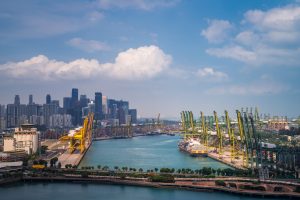When discussing the maritime domain, we often think of fishing and shipping activities, and how they can be better regulated or protected from pirates, criminals, or other hostile activities. What often gets forgotten is that today’s economies and supply chains increasingly depend on a wide array of maritime infrastructures.
Oil rigs, gas platforms, and the pipelines that connect them to the land are crucial fossil energy supply lines. Digital communication and access to the internet depends on underwater optic fiber data cables through which up to 95 percent of transnational data traffic runs. The green energy transition, vital to stopping global warming and climate change, implies new dependencies. Increasingly, energy production relies on offshore installations, such as wind farms or floating solar farms. These are the most effective carbon-neutral technologies available. Countries such as Vietnam or the Philippines have huge prospects for developing offshore wind energy and will be the region’s green power houses of the future. Green energy farms rely on underwater power cables to connect them to the land. Indeed, a new regional underwater electricity grid is in the making, which will provide the opportunity to trade electricity across large distances, including a new connection between Singapore and Australia.
However, this infrastructure at sea is very vulnerable. In Europe, the still unresolved sabotage of the Nord Stream pipelines that occurred in September 2022 in the Baltic Sea highlights how maritime infrastructure can become the direct target of attack. Reports from Taiwan suggest the frequent sabotage of underwater cables, underlining that such threats must also be taken seriously in the region. Extremist groups and criminals might target maritime infrastructures. Many of the risks are also related to everyday marine activities. Fishing vessels frequently damage cables, and the new scale of infrastructure at sea can pose new navigational hazards for shipping. The expansion of investments in maritime infrastructures for green energy and digital connectivity imply that these vulnerabilities will gain in importance.
So far, the protection of critical maritime infrastructure has hardly featured in the region’s security debates and plans. Neither maritime security, nor energy security and cyber security programs, have fully taken maritime infrastructure into account. An urgent discussion is needed on how national navies and coastguards can better protect these critical infrastructures. This will imply identifying how protection can be embedded into existing surveillance and patrolling programs, but also which skills and capacities they need to develop to deal with the expansion of infrastructure at sea. Countries must also review whether they have the right policies, spatial plans, and criminal laws in place to designate the infrastructures that are most critical for their economies and to enable the necessary law enforcement and prosecution. Yet, this is not exclusively or primarily a national task.
The majority of infrastructure projects are transnational, cutting through and connecting different national jurisdictions. With the expansion of green power grids, countries will become more and more inter-dependent and connected via a regional electricity market. Through underwater data cables Southeast Asian countries are not only connected to each other, but also to the world’s data centers and markets. The region’s security institutions, including, for instance, the recently initiated ASEAN Coast Guard Forum and the ASEAN Defense Ministers’ Meeting need to start discussing the issue. The goal must be to identify whether and how an integrated and coherent approach to protection and joint standards can be developed and best practices shared.
The region’s main information sharing institution, the Information Fusion Center (IFC) in Singapore has been a key vehicle for maritime security, and it has a vital role to play in critical maritime infrastructure protection as well. As a trusted institution it must start systematically collecting and sharing information on incidents that occur, and monitoring suspicious behavior in close proximity to key infrastructure. It should also start raising awareness of the current and future criticality of maritime infrastructure. The IFC, moreover, has strong experience in collaborating with industry stakeholders. It must expand its network through a close dialogue with the diverse sectors of maritime infrastructure industries, particularly the wind, solar, and cable industries.
Since safe and resilient maritime infrastructures are the lifeblood of the global economy and are required for the green transition, enhancing protection is in everyone’s interest. While ASEAN countries must ensure the safety of its regional infrastructure, this applies to extra-regional countries as well. Donors and capacity building providers in the region, notably states with strong export-oriented infrastructure industries, such as Denmark, Japan, the United Kingdom, and the United States, must support the countries in the region to develop reliable strategies and capacities.

































